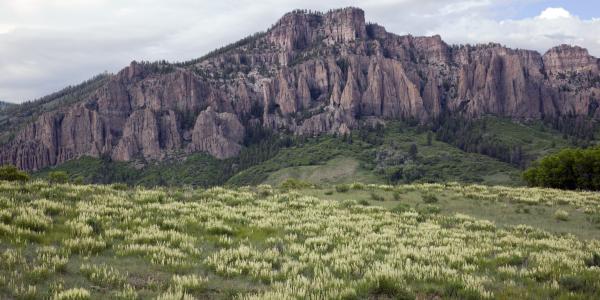I was in the kitchen when I noticed birds on the forsythia bush.
I went closer, and although they were just outside the window, I did not recognize them. So I got my camera, took some photos and consulted an expert.
Stephen Jones identified them as American bushtits, Psaltriparus minimus.
American bushtits, Psaltriparus minimus, are so gregarious, they are in your face. Click here for larger image. Photo by Jeff Mitton.
They were active and agile, often hanging upside down to search the underside of twigs. They were harvesting something tiny, perhaps some scale insects or spiders.
This flock of 15 moved between the forsythia and the cotoneaster hedge, with everyone constantly emitting soft peeps to keep track of everyone else.
When I approached this group of three (see the photo) too closely, they flew off. But they did not fly away, but at me, passing within a foot of my head. So I was buzzed by a gang of small but cheeky birds.
I had not seen bushtits before, but apparently they are moving into Boulder County along with great-tailed grackles, eastern phoebes and white-winged doves.
Causes for these immigrations are discussed by Stephen Jones and Ruth Carol Cushman in their article "Southern birds move up into Boulder County," which appeared recently in the Camera.
Numerous species of tits are native to Europe and Asia, but bushtits are the sole species in North and Central America. However, bushtits are distributed from British Columbia to Guatemala and from the west coast to Colorado and western Texas, and in this large range they vary considerably.
One way to describe the variation is to recognize three groups with nine subspecies, though the experts have not yet come to consensus on this classification. All of the subspecies along the Pacific coast have brown caps, while the birds inland have grey caps. The sexes look similar except that females have yellow eyes and males have dark eyes.
Bushtits are tiny, just 4.3 inches long. One might think that such small birds would migrate south for the winter, as hummingbirds do, but bushtits are resident throughout their range.
However, those living high in the mountains may move to lower sites in winter. They take particular care in weaving pendant nests of spider web, feathers, fur and fluffy plant material, and camouflaging it with plant material.
Parents and helpers take up to a month to build the nest, which is occupied by two broods per season. When they are not nesting, bushtits sleep gregariously, huddling for warmth on branches. Calorimetric studies indicate that they save 20 percent of the cost of sleeping overnight if they can huddle with others.
In the Chiricahua Mountains in Arizona, American bushtits practice cooperative breeding. This breeding strategy, found in only 8 percent of bird species, employs one to four "helpers" at the nest. Breeding is not obligately cooperative — only about one-third of nests are attended by helpers, which are usually adult males not closely related to either of the parents. Parents, nestlings and helpers sleep in the same nest.
DNA surveys of families were conducted to determine if the helpers were sneaking copulations when the male parent was away from the nest. But the data indicated that each brood was produced solely by the parents.
This is a bit of a puzzle, for if the helpers are not related to the family that they feed, what is their motive?
It seems that helpers attend the nest in the hopes of replacing the male parent to produce the second brood of the season. If the male parent leaves the nest, one of the helpers replaces him, inheriting the mate and the nest and gaining the opportunity to raise his own family.




